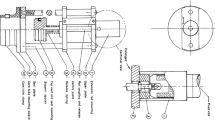Abstract
A new coring device is presented which allows the recovery of loose watery surface sediments and the water/sediment interface byin situ freezing, resulting in well preserved samples. The instrument consists of a tripod with adjustable legs, a hydraulic system, an insulated thermos (with two electrical pumps), and a wedge-shaped freeze box. Alcohol chilled with dry ice is the freezing agent. The corer can be deployed from a boat or a raft and permits recovery of undisturbed surface sediment sections up to 100 cm long in deep waters. The corer is particularly useful for sampling varved sediments.
Similar content being viewed by others
References
Anderson, R.F., S.L. Schiff and R.H. Hesslein, 1987. Determining sediment accumulation and mixing rates using210Pb,137Cs, and other tracers: problems due to postdepositional mobility or coring artifacts. Canadian Journal of Fishery and Aquatic Science 44:231–250.
Blomqvist, S., 1991. Quantitative sampling of soft-bottom sediments: problems and solutions. Marine Ecology Progress Series 72:295–304.
Blomqvist, S. and B. Abrahamsson, 1985. An improved Kajak-type gravity core sampler for soft bottom sediments. Schweizerische Zeitschrift für Hydrologie 47:81–84.
Chant, L. and R.J. Cornett, 1991. Smearing of gravity core profiles in soft sediments. Limnology and Oceanography 36:1492–1498.
Cornett, R.J. and L. Chant, 1993. Comment on “Core compression and surficial sediment loss of lake sediments of high porosity caused by gravity coring”. Limnology and Oceanography 38:695–699.
Crusius, J. and R.F. Anderson, 1991. Core compression and surficial sediment loss of lake sediments of high porosity caused by gravity coring. Limnology and Oceanography 36:1021–1031.
Glew, J.R., 1991. Miniature gravity corer for recovering short sediment cores. Journal of Paleolimnology 5:285–287.
Hongve, D. and A.H. Erlandsen, 1979. Shortening of surface sediment cores during sampling. Hydrobiologia 65:283–287.
Huttunen, P. and J. Meriläinen, 1978. New freezing device providing large unmixed sediment samples from lakes. Annales botanici Fennici 15:128–130.
Klee, R. and R. Schmidt, 1987. Eutrophication of Mondsee (Upper Austria) as indicated by the diatom stratigraphy of a sediment core. Diatom Research 2:55–76.
Lamoureux, S.F., 1994. Embedding unfrozen lake sediments for thin section preparation. Journal of Paleolimnology 10:141–146.
Lotter, A.F. The recent eutrophication of Baldeggersee (Switzerland), as assessed by fossil diatom assemblages. The Holocene: in press.
Lotter, A.F., M. Sturm, J.L. Teranes and B. Wehrli, 1997. Varve formation since 1885 and high-resolution varve analyses in hypertrophic Baldeggersee (Switzerland). Aquatic Sciences 59: 304–325.
Merkt, J., 1971. Zuverlässige Auszählungen von Jahresschichten in Seesedimenten mit Hilfe von Gross-Dünnschliffen. Archiv für Hydrobiologie 69:145–154.
Miskimmin, B.M., P.J. Curtis, D.W. Schindler and N. Lafaut, 1996. A new hammer-driven freeze corer. Journal of Paleolimnology 15:265–269.
Pachur, H.-J., H.-D. Denner and H. Walter, 1984. A freezing device for sampling the sedimentwater interface of lakes. Catena 11:65–70.
Parker, W.R. and G.C. Sills, 1990. Observation of corer penetration and sample entry during gravity coring. Marine Geophysical Researches 12:101–107.
Pollingher, U., H. Ambühl and H.R. Bürgi, 1992. A new method for processing clay-rich unconsolidated sediments for paleoecological investigations. Journal of Paleolimnology 7:95–101.
Renberg, I., 1981. Improved methods for sampling, photographing and varve-counting of varved lake sediments. Boreas 10:255–258.
Renberg, I., 1991. The HON-Kajak sediment corer. Journal of Paleolimnology 6:167–170.
Renberg, I. and H. Hansson, 1993. A pump freeze corer for recent sediments. Limnology and Oceanography 38:1317–1321.
Schaller, T., C. Moor and B. Wehrli, 1997. Sedimentary profiles of Fe, Mn, V, Cr, As and Mo recording signals of changing deep-water oxygen conditions in Baldeggersee. Aquatic Sciences 59:345–361.
Segerström, U. and I. Renberg, 1986. Calculating net annual accumulation rates of sediment components exemplified by pollen. Hydrobiologia 143:45–47.
Shapiro, J., 1958. The core-freezer—a new sampler for lake sediments. Ecology 39:748.
Wright, H.E., 1980. Coring of soft lake sediments. Boreas 9:107–114.
Wright, H.E., 1990. An improved Hongve sampler for surface sediments. Journal of Paleolimnology 4:91–92.
Author information
Authors and Affiliations
Rights and permissions
About this article
Cite this article
Lotter, A.F., Renberg, I., Hansson, H. et al. A remote controlled freeze corer for sampling unconsolidated surface sediments. Aquatic Science 59, 295–303 (1997). https://doi.org/10.1007/BF02522360
Received:
Accepted:
Issue Date:
DOI: https://doi.org/10.1007/BF02522360




